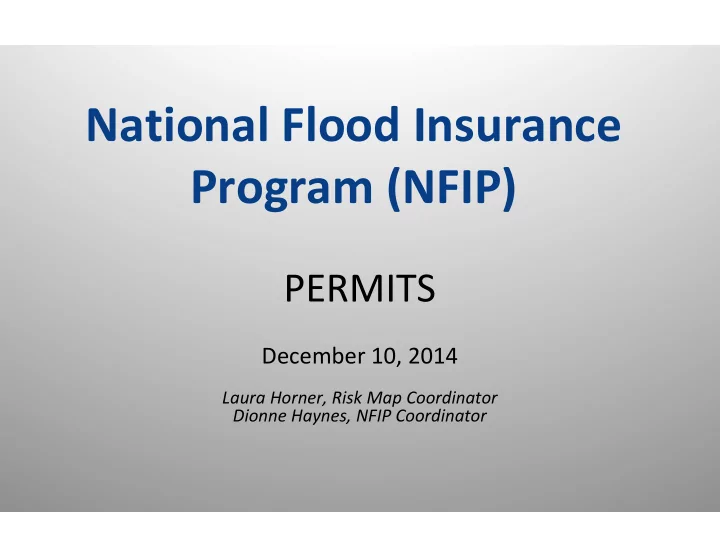

National Flood Insurance Program (NFIP) PERMITS December 10, 2014 Laura Horner, Risk Map Coordinator Dionne Haynes, NFIP Coordinator
Basis of the NFIP NFIP balances three program areas: 1. Flood Hazard Identification (mapping) Identifies Special Flood Hazard Areas (SFHA) 2. Flood Insurance 3. Floodplain Management (regulations) Permits
Risk Determination & Mapping • FIRMs can be searched and viewed online – FEMA Map Service Center (msc.fema.gov) • Flood Zones in North Dakota – Zone A: High risk, 1% (100yr flood) SFHA, a permit is needed. – Zone X: Low to moderate risk (500yr flood), no permit needed. – Zone D: Undetermined risk level, no permit needed.
FIRM Example Sutter Blvd. Fort Ross Ave. ZONE AE Monterey Ave. X ZONE X RM1 E D Vallejo Ave. Sonoma Ave. LIMIT OF DETAILED STUDY ZONE X Fremont St. Larkin St. Bidwell St. C ZONE A Alvarado Ave. B A
Purpose of Permits and Types
Who has Permitting Authority? • North Dakota has no formal permitting authority as a state entity in NFIP identified floodplain areas. • Permitting is always done at the local level – County – City – Township – Reservation
Office of the State Engineer
Governments and the NFIP • FEMA ‐ provides flood mapping, minimum floodplain management standards, flood insurance • State : ND State Engineer ‐ FEMA funded mapping and assists communities in floodplain management • Community ‐ adopts and enforces floodplain management standards according NFIP regulations and under state law
Updating FEMA Maps • When is a CLOMR (Conditional Letter of Map Revision) required? • Modification of the existing floodway or SFHA • Approved encroachment will cause a rise • What is a LOMR (Letter of Map Revision)? • FEMA’s revision to an effective FIRM
Thank You For more information, please visit these sites: Map Service Center http://msc.fema.gov NFIP http://www.floodsmart.gov General info http://www.fema.gov
Office of State Engineer Sovereign Lands PERMITS December 10, 2014 Gerald Heiser, Sovereign Lands Manager
Definitions • Sovereign Lands ‐ areas, including beds and islands, lying within the ordinary high water mark of navigable lakes and streams. • Navigable waters ‐ any waters which were in fact navigable at the time of statehood, that is, were used or were susceptible of being used in their ordinary condition as highways for commerce over which trade and travel were or may have been conducted in the customary modes of trade on water. • Ordinary High Water Mark ‐ the line below which the action of the water is frequent enough to prevent the growth of vegetation or to restrict its growth to predominantly wetland species. Islands in navigable waters are considered to be below the ordinary high water mark in their entirety. • Project ‐ any activity which occurs either partially or wholly on sovereign lands
Navigability – Federal Standards • Equal Footing Doctrine • United States Constitution Commerce Clause
Section 10 Waters • Red River of the North • Bois De Sioux • James River (Jamestown railroad bridge to the South Dakota border) • Missouri River • Upper Des Lacs Lake • Yellowstone River
Navigable Lakes and Streams • Missouri River • Knife River • Yellowstone River • Devils Lake • Red River • Lake Metigoshe • Sheyenne River • Painted Woods Lake • James River • Upper Des Lacs Lake • Pembina River • Sweetwater Lake • Mouse River • Lake Isabel • Cannonball River • Long Lake – Bottineau County • Heart River
Sovereign Land Permit Process 1. Application received by State Engineer. 2. Log in the application and assign a permit number. 3. Solicitation of views – includes a letter describing the project, the application and all attachments. 4. Comment period: 30 days from the date of the Solicitation of Views letter. 5. Prepare the permit and a memo to the State Engineer describing the project, all comments received, how those comments were addressed, and my recommendation whether to permit or deny the project. 6. The memo and permit are reviewed and initialed by the Chief of the Regulatory Division, the Section Chief, and either signed or denied by the State Engineer. 7. Mail the signed permit and a copy of all comments received or the denial letter to the applicant.
Thank You Gerald R. Heiser Sovereign Lands Manager Office of the State Engineer (701) 238 ‐ 4935 gheiser@nd.gov www.swc.nd.gov
Recommend
More recommend